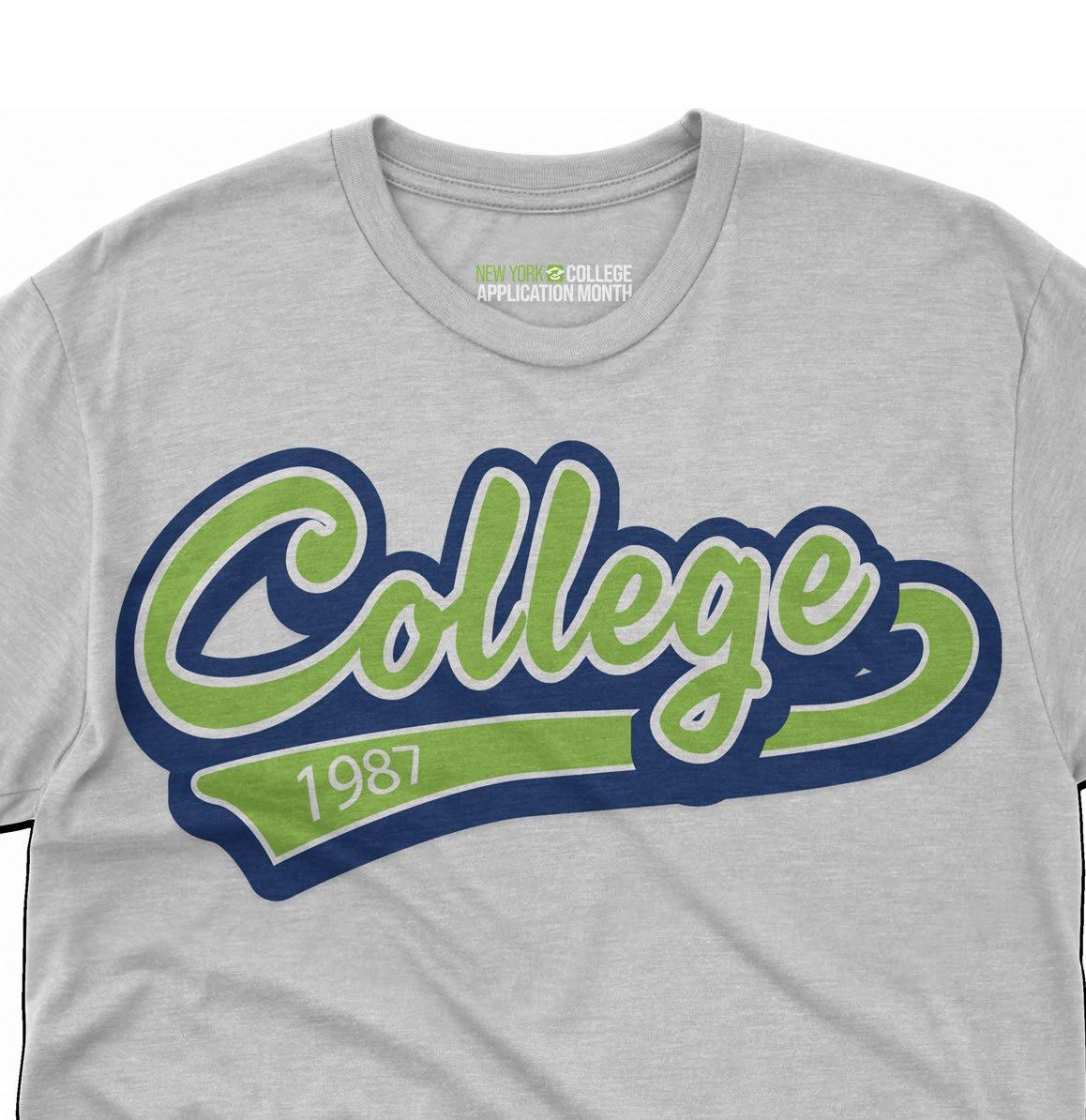

New York State is proud to participate in the National American College Application Campaign (ACAC), an effort of the American Council on Education (ACE) to increase the number of first-generation and low-income students who pursue postsecondary education.
Through New York College Application Month events at participating high schools, seniors receive critical help navigating the college admissions process and successfully submit at least one admissions application.



HESC.NY.GOV/CAM SITE COORDINATOR HANDBOOK



HESC.NY.GOV/CAM SITE COORDINATOR HANDBOOK SITE COORDINATOR CHECKLIST 4 SITE COORDINATOR WORKSHEET 6 SITE COORDINATOR CAMPAIGN TIMELINE 7 CAM EVENT SIGN IN/OUT 10 COLLEGE APPLICATION FEE WAIVER INFORMATION 11 SITE COORDINATOR BINGO 12 ASK ME ABOUT MY COLLEGE SIGN 13 STUDENT DAY-OF INSTRUCTIONS 14 10 STEPS TO APPLYING 16 BUILDING A BALANCED COLLEGE LIST 18 COLLEGE APPLICATION WORKSHEET FOR STUDENTS 19 COLLEGE RESEARCH WORKSHEET FOR STUDENTS 28 I'VE APPLIED, WHAT’S NEXT? 35 YOUR NEXT STEPS 36 BEST FAFSA FACT SHEET 38 FAFSA WHAT TO BRING CHECKLIST 39 FAFSA APPLICATION GUIDE 40 STUDENT AND FAMILY INFORMATION LETTER 42 VOLUNTEER RECRUITMENT LETTER 43 VOLUNTEER THANK YOU LETTER 44 TABLE OF CONTENTS
SITE COORDINATOR CHECKLIST
Pre-Event Preparation First Steps
Review New York’s College Application Month Site Coordinator Manual.
Identify and reserve site with computers for College Application Event.
Add College Application Event to school calendar.
Use this checklist to assist in planning your College Application event.
Identify a School Team to build support and assist with tasks; use the Site Coordinator Worksheet.
Reserve computer labs and/or secure electronic platforms for use during CAM events.
Work with art teachers to create classroom challenge for CAM post/social media design.
Ask 12th grade English teachers to include college essay writing assignments for completion prior to CAM events.
Reach out to PTA for volunteers.
Host a School Team meeting to discuss implementation of program at your school.
Solicit volunteers from your School Team to ensure you have adequate counts of ACT, SAT, and/or NACAC fee waivers available for your students’ use.
Communicate College Application Event Throughout School Community
Distribute email/HESC text blasts to students and parents.
Post information on school website and school marquee.
Include event details in the morning announcements, school newsletters, and newspaper.
Issue a pre-event news release.
Prepare Students for the Event
Promote activities encouraging students to research and identify schools that best fit them. Find resources at hesc.ny.gov/cam.
Sponsor and/or support participation in virtual college fairs or visits.
Distribute College Application Worksheets for students to complete before the event.
Implement college exploration and preparation assignments in classrooms.
Identify and meet with students eligible for application fee waivers.


HESC.NY.GOV/CAM SITE COORDINATOR HANDBOOK
4
Build Awareness and Enthusiasm
Encourage teachers to promote college discussion by wearing college swag, decorating their classrooms/ backgrounds with their college logos, and invitations to “Ask me about my college.”
Sponsor a “College Door” decorating contest.
Include College Application Event information in the morning announcements.
Host guest speakers to talk about their college experiences.
Conduct a parent/student College Application Event information meeting.
Engage underclassmen in the school’s College Application Campaign event.
Organize Event Volunteers
Communicate event specifics.
Assign tasks and provide training, if necessary.
Ask volunteers to wear college logo clothing during event.
Check Last-minute Details
Communicate event specifics to volunteers.
Remind seniors to complete their College Application Worksheet.
Arrange student counselor meetings to finalize application fee waivers.
Confirm technology needs with school/district technology team.
Ensure students have created an FSA ID.
Hold College Application Event
Distribute Today I Will Apply sheets to students at sign in.
Ensure students sign in.
Ensure students receive the I Applied, Now What?, Better FAFSA, and the Complete Your FAFSA information sheets.
Post-Event Follow-Up
Customize the Volunteer Thank You Letter to send to all volunteers.
Analyze results from student sign out sheet, submit to state coordinator at thepath@hesc.ny.gov.
Host post-event debrief with school team.
Release post-event news release.
Follow up with students to ensure they complete the college admissions and financial aid application processes.


HESC.NY.GOV/CAM SITE COORDINATOR HANDBOOK
SITE COORDINATOR WORKSHEET
Potential Partners
Admissions Representative (Local College)
Local Business Leader
Local Liberty Partnership Program Coordinator
Local College Access Challenge Grant Sub-grant Coordinator
Faith-based Community Representative
Non-profit Representative
PTA or Parent Representative
Student Representative
HESC Representative
SED Representative
Other
Use the table below to identify potential education partners in your school’s College Application Campaign.


HESC.NY.GOV/CAM SITE COORDINATOR HANDBOOK
Contact Name Email Phone 6
SITE COORDINATOR CAMPAIGN TIMELINE
Although New York State’s College Application program is in October, your site must begin planning for the program early, ideally giving yourself at least four weeks to plan. Below is a recommended timeline for your College Application Event. The timeline may need to shift based on the dates selected for your state’s event program and your school's schedule. Most of these tasks will need to be implemented annually, so keep this timeline for future reference!
SPRING OR START OF SCHOOL YEAR
• Register your school/organization for participation in the NYS College Application Campaign program.
• During spring course enrollment meetings with juniors, make each student aware of the College Application program and encourage them to consider and research the colleges and universities to which they want to apply.
• Review the current site coordinator resources provided at hesc.ny.gov/cam.
• Establish a team (school administrators, school counselors, college access personnel, students) to assist with your school’s/organization’s preparations.
• Add the College Application event date(s) to your school’s/organization’s public calendar.
• Reserve the computer facilities for your school’s/organization’s College Application event.
• Ensure you have adequate knowledge of how to obtain fee waivers for students who cannot afford the application fees. Visit www.hesc.ny.gov/cam for available fee waiver resources.


HESC.NY.GOV/CAM SITE COORDINATOR HANDBOOK
7
4 WEEKS PRIOR TO YOUR EVENT
3 WEEKS PRIOR TO YOUR EVENT
• Consider hosting a recommendation letter writing workshop for School or District leads. Encourage them to share with counselors and teachers new to the process.
• Inform students they should start on any required essays or personal statements.
• Create a schedule for any volunteers.
2 WEEKS PRIOR TO YOUR EVENT
• Remind families of your school’s College Application event using your school web portal, blast emails, newsletters, and social media to let them know their students may need help preparing.
• Send a message to your volunteers to give them the event details, including when and where to meet.
• Remind students to continue working on any required essays or personal statements.
• Send a notification to parents/guardians explaining the day and when it is happening so they can help prep their children.
• Remind families that now is the time to sit down with their child about the colleges on their list.
• Remind teachers, counselors, and administrators of the event schedule and ensure all seniors will have the opportunity to participate. Be sure you have and use event materials available at www.hesc.ny.gov.
1 WEEK PRIOR TO YOUR EVENT
• Make an announcement to remind students that the event is next week, and remind them that they will need to:
• Research schools and know where they would like to apply.
• Have a plan for application fees and to speak with their school counselor if they believe they qualify for a fee waiver.
• Confirm that required essays or personal statements are proofed and in final version. They should have access to it from the cloud, an email attachment, or on a thumb drive.
• Gather the information needed to complete applications. Some information may need to come from families (residency information, social security number, etc.). Use the ACAC Student Application Worksheet to help them keep track of their information.
• Encourage school staff to wear college clothing on the day(s) of the event.
• Alert your local media about your event. A press release template is available at www.hesc.ny.gov/cam.
• Use the Student Application Worksheet to help them keep track of their information.
• Place a reminder about the event on your school’s website and parent portal.
• Confirm all volunteers and staff understand the data collection process.


HESC.NY.GOV/CAM SITE COORDINATOR HANDBOOK
YOUR COLLEGE APPLICATION
DAY! AFTER YOUR EVENT
• Eligible students should register for their FSA ID during the College Application event.
• Participating students should “sign out” of the event and provide the requested information. This is a critical step for proper data collection.
• Ensure students get the Next Steps and FAFSA Completion event handoutsavailable at www.hesc.ny.gov/cam.
• Remind students to complete the college application process by ensuring they submit their transcripts, letters of recommendation, and/or college entrance exam scores to the institutions to which they applied.
• Remind students to share where they applied through the CAM event sign out sheet.
• Be sure to complete the HESC post-event survey to report your CAM event numbers and give any feedback on the event or the resources you’d like HESC to offer to help support the CAM initiative.


HESC.NY.GOV/CAM SITE COORDINATOR HANDBOOK
CAM EVENT SIGN IN/OUT


HESC.NY.GOV/CAM SITE COORDINATOR HANDBOOK Student First & Last Name 1. 2. 3. 4. 5. 6. 7. 8. 9. 10. 11. 13. 15. 12. 14. 16. 18. 20. 17. 19. Colleges You Applied To Created FSA ID? (Yes or No)
10
NYS COLLEGE APPLICATION FEE WAIVER INFORMATION
With college application fees averaging $35 to $50 or more, applying to several colleges can be expensive and may be prohibitive for some families.
However, students of families experiencing financial hardship may be eligible for waivers of their college application fees. Both the College Board and the National Association for College Admission Counseling (NACAC) provide waiver request forms that can be completed by eligible students and are accepted by many colleges. The State University of New York (SUNY) and the City University of New York (CUNY) require the use of their own waiver request forms.
Let your students and their parents know that they may be eligible for application fee waivers through these opportunities:

Students who previously received a fee waiver from the College Board for the SAT will receive four application waivers directly from the College Board through their College Board accounts. Students are assigned a unique fee waiver code they can submit with four college applications. The colleges and universities that accept SAT waivers are listed in the SAT Fee Waiver Directory of Colleges.

Students who did not take the SAT and those who did but are applying to more than four schools can use the NACAC Request for Application Fee Waiver. This form is completed by students with the help of their high school counselor. Suggested annual family income guidelines for this waiver depend on family size. However, income is not the only determining factor in application fee waivers; many are based on the counselor’s knowledge of family circumstances.

Students applying to SUNY who face significant financial hardship may also request their application fees be waived by having their school counselor complete and submit a SUNY Fee Waiver Request Form. The State University waives the $50 application fee for up to four college choices. Students eligible for a fee waiver should select “Fee Waiver” as their payment method. If a fee waiver request is submitted and the student is later found ineligible, the student will be required to submit payment before the application will be processed.

CUNY accepts only CUNY fee waivers; no other type of fee waiver is accepted. Students can request CUNY fee waivers from their counselor/college advisors at their high schools. A very limited quantity of CUNY fee waivers are provided to high school counselors/ college advisors to be distributed to current students with the most financial need. No additional waivers will be provided once the high school’s supply of CUNY fee waivers is exhausted.


HESC.NY.GOV/CAM SITE COORDINATOR HANDBOOK
11
SITE COORDINATOR BINGO
Bingo Rules:
• Find a teacher, administrator or other adult in your school for whom one of the statements are true.
• Ask that person to sign the box that contains their true statement.
• Up to five people may sign the sheet twice.
• Get five in a row — horizontally, vertically, or diagonally — including the free space!
NEVER THOUGHTS THEY WOULD GO TO COLLEGE
PARTICIPATED IN STUDENT GOVERNMENT
LIVED AT HOME WHILE IN COLLEGE
WENT TO A COMMUNITY COLLEGE
STUDIED IN ANOTHER COUNTRY WHILE IN COLLEGE
TRANSFERRED FROM ONE COLLEGE TO ANOTHER WENT TO COLLEGE MORE THAN 500 MILES FROM HOME
RECEIVED A SCHOLARSHIP TO HELP PAY FOR COLLEGE
HAD AN INTERNSHIP
DID VOLUNTEER WORK WHILE IN COLLEGE
WAS IN COLLEGE FOR MORE THAN FOUR YEARS
BELONGED TO A STUDENT GROUP OR CLUB

GRADUATED WITH A BACHELOR’S DEGREE IN FOUR YEARS
WAS THE FIRST IN THEIR FAMILY TO GO TO COLLEGE
STUDIED ON A SATURDAY NIGHT WHILE IN COLLEGE
ATTENDED A PRIVATE COLLEGE
CONDUCTED SCIENTIFIC RESEARCH
CHANGED THEIR COLLEGE MAJOR AT LEAST ONE TIME
TOOK OUT STUDENT LOANS TO HELP PAY FOR COLLEGE
BELONGED TO A FRATERNITY OR SORORITY
ATTENDED A STATE COLLEGE OR UNIVERSITY
HAD A JOB WHILE IN COLLEGE
LIVED IN A COLLEGE RESIDENCE HALL
PLAYED A SPORT WHILE IN COLLEGE


HESC.NY.GOV/CAM SITE COORDINATOR HANDBOOK
12
ASK ME ABOUT MY

Use this 9-step checklist to assist in planning for College Application Month events.
1. Apply Online - Find the websites you need Common Application - For participating colleges.
Check with your school counselor or volunteer if you are unsure. SUNY Application. CUNY Application.
College Websites.
2. Complete College Applications Fill in all required information. Ask for help if you need it.


HESC.NY.GOV/CAM SITE COORDINATOR HANDBOOK
5. Print Copy of Application Confirmation Pages Create a college application folder and save all application confirmation pages.
3. Complete Information Correctly Legal Name, not nickname.
Individual
4. Check Off the Crucial Items Needed to Submit Today Essays. Application Fee or Fee waiver. SAT or ACT Scores. Transcripts. Recommendation Letters. DAY-OF INSTRUCTIONS FOR STUDENTS
14


HESC.NY.GOV/CAM SITE COORDINATOR HANDBOOK 6. Register for an FSA ID FSA ID - needed to apply for financial aid through the Free Application for Federal Student Aid Form - the FAFSA. Most grants, loans, and scholarships require the FAFSA, so this is very important. Get an FSA ID at studentaid.gov/fsa-id/create-account 7. Take Home the ‘I Applied! What’s Next? Complete Your FAFSA Flyer 8. Follow-up! 9. The FAFSA Will Be Available in December - Watch For It! Keep track of what happens next and prepare for the FAFSA. Submit any additional items from #4 to your colleges. Congratulations! You’re on your way to college!
10 STEPS TO APPLYING
Your school’s College Application Event will assist you with the college application process. Be aware there are several things you will need to do after today to complete the college application process. Please refer to our “Next Steps for Students” document to know what will happen after the application process, including applying for financial aid.
Some colleges charge an application fee. You might be eligible for a fee waiver. Ask your counselor if you are unsure.
Applying online? Go to the college(s) websites where you will apply. Check with your school counselor or a volunteer if you are unsure. If you are not applying to college online, get a hard copy of the admissions application from your school counselor.
Complete the application(s) to the colleges and universities you want to apply to. Some applications will ask you for information you may need to gather in advance with your family. Please see our College Application Worksheet to know what is commonly asked.
Make note of any additional items you need to submit with your application (essay, transcripts, ACT or SAT scores, recommendation letters).
Print out a copy of your confirmation page if you applied online. If you are applying through a paper application, be sure to make a copy for your records!


HESC.NY.GOV/CAM SITE COORDINATOR HANDBOOK
16
yourschoolurl.org Admissions Applications NotebookNotebook College Folder College Folder STEP 1 STEP 2 STEP 5 STEP 4 STEP 3
Financial Aid Checklist
STEP 7:
Don’t forget to sign out after you submit your college application. You’ll need to list the number or names of colleges you applied to and indicate whether you created an FSA ID.
STEP 6:
Prepare to apply for financial aid. US citizens, permanent residents, and other eligible non-citizens should plan to submit a Free Application for Federal Student Aid (FAFSA). You can do that at studentaid.gov. You’ll need your Social Security Number (SSN), mailing address, and email address to complete the process. If you are not eligible for federal student aid, you might qualify for state financial aid. Talk to your counselor about your options.
STEP 9:
Follow-up! Make sure you submit any additional information the colleges you applied to require. This could include recommendation letters, test scores, and high school transcripts.
STEP 10:
You already have your FSA ID; make sure you submit your FAFSA early. This year, the FAFSA will be released in December. File early for the best chance of getting more financial aid.
FSA ID
STEP 8:
Be sure to get the handouts provided by your school after you sign-out!



HESC.NY.GOV/CAM SITE COORDINATOR HANDBOOK
Congratulations! You are on your way! Have you applied to college yet?? Get on it! Its College App Month! I haven't, thanks for the reminder!
CAM WAIVER
BUILDING A BALANCED COLLEGE LIST
Apply to colleges that are right for you! You’ll thrive in a college that matches your goals. Meet with your school counselor or other trusted adult or mentor. They can help you work through these five steps:
STEP WHY HOW
To know which colleges will serve you best, you have to know yourself. What do you enjoy? What drives you? Use those answers to help you determine your major and future career aspirations.
Reflect on your values, academic profile, and what you’d like to experience during college. Remember, affordability is also a major factor when building your college list.
There are more than 4,000 postsecondary institutions in the United States. Research is important to help you find your perfect college match.
Once you have a list of colleges that match your needs, sort them into the following categories:
Likely: These schools fit your profile and accept students with your GPA and test scores.
Target: Your profile, GPA, and test scores match the school’s typical student.
Reach: These schools typically accept students with higher GPAs and test scores.
Balance your likely, target, and reach lists, and apply to colleges in all three categories. You’ll find schools that meet your needs and offer an academic environment where you will thrive.
Now that you have your final list, research application timelines, admission requirements, deadlines, and fees before you start the online application process.
Use free tools at bigfuture.collegeboard.org to match you with colleges that meet your needs and expectations.
Know your numbers! Knowing your GPA, class rank, and ACT/SAT scores, you can compare those numbers to each college’s average student profile.
To build a balanced list, choose at least two schools in each category. You can always add more, but keep your total to less than ten schools.
Visit each school’s website and learn about the types of admission, deadlines, and application fees they have. If your schools are using the Common Application, you can submit one application for multiple schools!


HESC.NY.GOV/CAM SITE COORDINATOR HANDBOOK
18
PERSONAL REFLECTION 1. PRIMARY RESEARCH 2. SORT: LIKELY/ TARGET/ RESEARCH 3. NARROW & BALANCE 4. PREPARE & APPLY 5.
COLLEGE APPLICATION WORKSHEET
A STUDENT RESOURCE GUIDE








HESC.NY.GOV/CAM SITE COORDINATOR HANDBOOK
19


PLAN TO APPLY
Students, complete the College Application Worksheets included in this document and bring them with you on the day of your school’s College Application event. You may need to ask your family, school counselor, or another adult you trust to assist you in answering all of the following questions. Be sure to keep this information safe, given the personal information included.


HESC.NY.GOV/CAM SITE COORDINATOR HANDBOOK TABLE OF CONTENTS NARROW DOWN YOUR LIST........................................................................................................ 21 WHERE YOU PLAN TO APPLY..................................................................................................... 22 GATHER YOUR PERSONAL INFORMATION....................................................................... 24
tool to help students plan for and complete application forms.
A
NARROW YOUR LIST
Before participating in your school’s College Application event, research the schools you plan to apply to and learn what each school requires in their application. As you narrow down your list, we recommend applying to at least four colleges: one to two reach schools, one to two target schools, and one likely school. Our College Research Worksheet can help you determine your final reach, target, and likely college list of where to apply. Use the worksheet on the following page to keep track of the information you learn during your research on your top four colleges and universities.
Reach Schools Target Schools
Schools
ABOUT ESSAYS AND PERSONAL STATEMENTS
You write your essays and personal statements before your school’s College Application event. Your English teacher, School Counselor, and other adults you trust are good resources to assist you in getting your essays to a final version. You should bring a final, proofed, electronic copy of your essays and/or personal statements saved in an electronic format you can access during the event.


HESC.NY.GOV/CAM SITE COORDINATOR HANDBOOK
Likely
TOP FOUR COLLEGES AND UNIVERSITIES WHERE YOU PLAN TO APPLY
1. Name of College
1) Is an essay or personal statement required to apply?
2) Deadline date for application: __/__/____
3) Cost to Apply: $____________ 4) Payment options accepted: $____________ 6) SAT required?
5) ACT required?
7) Recommendation letter required?
8) Deadline date for scholarship or financial aid: __/__/____
9) Notes:
2. Name of College
1) Is an essay or personal statement required to apply?
2) Deadline date for application: __/__/____
5) ACT required?
7) Recommendation letter required?
8) Deadline date for scholarship or financial aid: __/__/____
9) Notes: Yes No
3) Cost to Apply: $____________ 4) Payment options accepted: $____________ 6) SAT required?


HESC.NY.GOV/CAM SITE COORDINATOR HANDBOOK
Yes
Yes
Yes
Yes
No
No
No
No
Yes
Yes
Yes No
No
No
NARROW YOUR LIST CONTINUED
3. Name of College
1) Is an essay or personal statement required to apply?
2) Deadline date for application: __/__/____
3) Cost to Apply: $____________ 4) Payment options accepted: $____________ 6) SAT required?
5) ACT required?
7) Recommendation letter required?
8) Deadline date for scholarship or financial aid: __/__/____
9) Notes:
4. Name of College
1) Is an essay or personal statement required to apply?
2) Deadline date for application: __/__/____
3) Cost to Apply: $____________ 4) Payment options accepted: $____________ 6) SAT required?
5) ACT required?
7) Recommendation letter required?
8) Deadline date for scholarship or financial aid: __/__/____
9) Notes:


HESC.NY.GOV/CAM SITE COORDINATOR HANDBOOK NARROW YOUR LIST CONTINUED
Yes No Yes No Yes No Yes No
Yes No Yes No Yes No Yes No
GATHER YOUR PERSONAL INFORMATION
TEST SCORES
Some four-year colleges will request your college admissions test (ACT or SAT) scores. Use the space below to list the scores for tests you have already taken. If you still need to take the ACT or SAT and the school(s) you are applying to require them, speak with your school counselor about upcoming test dates - you will need to take at least one of these college entrance exams soon! Colleges that request test scores often require them to be “official“ and sent by ACT (ACT Scores) or College Board (SAT Scores). Talk with your school counselor about how to do this.
Composite Score:
English Score:
Mathematics Score:
Reading Score:
Science Score:
Writing Score (optional):
SAT
Composite Score:
English Score:
Mathematics Score:
Reading Score:
Science Score:
Writing Score (optional):


HESC.NY.GOV/CAM SITE COORDINATOR HANDBOOK
ACT
Test #1: Date Taken: __/__/____
Test #1: Date Taken: __/__/____
Test #1: Date Taken: __/__/____
Total
Evidence-Based Reading
Mathematics Score: Mathematics Score: ACT 28
1350
Test #1: Date Taken: __/__/____
Total Score:
Score: Evidence-Based Reading & Writing Score:
& Writing Score:
SAT
EXTRA-CURRICULAR ACTIVITIES
Some applications request information about the activities you participate in outside your high school classes. This should include co-curriculars, community service, part-time jobs, or any other activity you want to share with the college. These experiences allow you to learn from more than yourself, build relationships outside of school, and build exposure. List your activities below, including the year(s) you participated and if you held a position or received an award related to the activity.
Activity 1
Name of Activity:
Years Participated:
Leadership Position Held:
Activity 2
Name of Activity:
Years Participated:
Leadership Position Held: Awards:
Activity 3
Name of Activity:
Years Participated:
Leadership Position Held:
Activity 4
Name of Activity:
Years Participated:
Leadership Position Held: Awards:
Activity 5
Name of Activity:
Years Participated:
Leadership Position Held:
Activity 6
Name of Activity:
Years Participated:
Leadership Position Held: Awards:
Activity 7
Name of Activity:
Years Participated:
Leadership Position Held:
Activity 8
Name of Activity:
Years Participated:
Leadership Position Held:


HESC.NY.GOV/CAM SITE COORDINATOR HANDBOOK GATHER YOUR PERSONAL INFORMATION CONTINUED
Awards:
Awards:
Awards:
Awards: Awards:
PERSONAL INFORMATION
Many colleges will ask you to provide information related to your residency and citizenship. You may need to provide the following information when completing your application. If you are uncertain about an answer, your parent or guardian may be able to help.
Personal Information Worksheet
1) Have your Social Security Number ready!
2) Place of Birth:
3) County of Residency:
4) Have you ever lived in a state other than your current state of residence?
If yes, how many years have you lived in your current state of residence? __________
When did you move to your current state of residence? (this may be your birthdate) __/__/____
5) Provide your address(es) for where you have lived the last five years.
6) Citizenship Status (circle one):
7) Did your parent(s)/guardian(s) pay state income taxes last year?
If yes, in which state? _________________
8) Did you have a parent or guardian who is currently on active duty in the military? City: _______________ State: _______________
9) Employment Information: List any employment you have held for the last two years, including dates:
Address 1: _________________________________________________________________________________ Employer: ___________________________
Address 2: _________________________________________________________________________________


HESC.NY.GOV/CAM SITE COORDINATOR HANDBOOK GATHER YOUR PERSONAL INFORMATION CONTINUED
SSN is required to get your FSA ID. Keep this info private & safe. Memorize your SSN #
Country: _______________
Employer: __________________________
Employer:
Employer: __________________________
Employer: ___________________________ Employer: __________________________ Yes No Yes No Yes No USCitizen PermanentResidentAlien NonresidentAlien Other
___________________________
Address 3: _________________________________________________________________________________
COLLEGE APPLICATION INFORMATION
Many colleges will ask for information regarding your college plans. You will be asked what subject area you intend to major in and for which term you are applying. Do research before your school’s College Application event regarding whether the colleges you are interested in have the major you want to study. If you do not know what you want to study, that’s okay! You can work with your school counselor while you are still in high school to do career exploration. My ACT (http://my.act. org) and College Board’s Big Future (www.bigfuture.org) provide personalized college and career exploration to help. There will also be resources on the college campuses to assist with this. If you don’t know the subject area in which you want to major, you can likely apply as “undecided,” but do your research before the College Application event to ensure that is an option at the schools you plan to apply to.
Regardless, you can also change your major once you are enrolled in college.
YOUR INTENDED PROGRAM OR MAJOR: TERM YOU ARE APPLYING:
(Note: For most graduating seniors, the term will be fall enrollment following your graduation from high school).


HESC.NY.GOV/CAM SITE COORDINATOR HANDBOOK GATHER YOUR PERSONAL INFORMATION CONTINUED
COLLEGE RESEARCH WORKSHEET
A STUDENT RESOURCE GUIDE

WHERE TO APPLY
A tool to assist students in researching and identifying colleges that are a good match.


HESC.NY.GOV/CAM SITE COORDINATOR HANDBOOK
28
UNDERSTANDING FIT, MATCH, & COST
Before submitting a college application, you need to research the various available college options.
DOES THE COLLEGE FIT WITH YOUR PREFERENCES?
There are several factors to consider with regard to fit, such as the size of the school, the location of the school, services available on campus, and how these align with the characteristics you want in a college. Also, it is important to consider the college’s graduation rates and retention rates (the number of students who return to school for their second year) when researching what a college has to offer you. Finally, does the school offer your major?
If you’re not sure what you’d like to major in, there are a number of college and career planning resources your school may already be using. Ask your school counselor if they have a preferred tool.

IS THIS COLLEGE FOR ME?


HESC.NY.GOV/CAM SITE COORDINATOR HANDBOOK
TABLE OF CONTENTS DOES THE COLLEGE FIT? ............................................................................................................. 29 DOES THE COLLEGE MATCH? .................................................................................................. 30 WHAT ABOUT COST? ...................................................................................................................... 30 THE COLLEGE RESEARCH WORKSHEET ......................................................................... 32
FIT, MATCH,
COST
&
DOES THE COLLEGE MATCH WITH YOUR ACADEMIC RECORD?
For this, you’ll need to understand how your high school grade point average (GPA), your college entrance exam scores (SAT and/or ACT), and the courses you’ve taken in high school match the college’s entrance requirements AND to the average GPAs and scores of students admitted. Keep in mind that what a school requires could be different from the averages of who they admit. You should plan to apply to at least four schools, making sure you have applications going to each of the following types of schools:
• REACH SCHOOL - a reach school does not mean out of reach; it just means that the school may be more selective (look at the percentage of applicants admitted), and your academic record may be on the lower end of what the college typically accepts. In other words, you may be admitted to this school. We recommend at least 1-2 applications to reach schools.
• TARGET SCHOOL - typically, at a target school, your academic record will be similar to the “average” student admitted to this school. In other words, you are likely to be admitted. We recommend at least two applications to target schools.
• LIKELY SCHOOL - a likely school will usually have open enrollment (meaning anyone submitting a completed application is admitted) or will be considered a “less selective” institution. Your academic record will exceed the institution’s requirements and averages for students admitted. In other words, you will almost definitely be admitted. We recommend at least one application to a likely school.
• LOCAL SCHOOL - ensure that at least one of the schools on your list is local to you. If possible, this should be a school you can attend while living at or close to home if your circumstances require you to do so now or in the future.
WHAT ABOUT COST?
Finally, it is important for you to understand the cost of the institutions to which you would like to apply. Keep in mind that the “sticker” price of a college may be very different from the “net” price of a college after you consider the amount of aid that is typically available to students.
Check out these net price calculators to help you calculate your cost or check if the colleges you are interested in have a similar calculator:
• U.S. Department of Education: https://collegecost.ed.gov/net-price
• College Board’s Big Future: https://bigfuture.collegeboard.org/pay-for-college/ paying-your-share/focus-on-net-price-not-sticker-price





















HESC.NY.GOV/CAM SITE COORDINATOR HANDBOOK UNDERSTANDING FIT, MATCH, AND COST CONTINUED
NEXT STEPS
DOES THE COLLEGE MATCH WITH YOUR ACADEMIC RECORD?
Use the worksheet on the next few pages to think through what type of college you would like to attend. The worksheet will also ask you to detail your academic record by providing information on the various academic indicators many colleges consider during the application review process. If you are unsure of any of the information requested, be sure to work with your school counselor so you have the most accurate information possible.
After the worksheet, you will find a table you can complete with information about the colleges you are researching. Remember, you should plan to apply to at least one to two reach, one to two target, one likely, and one local college.
Students can utilize the following national resources: your state’s college website or the website of the college(s) you are interested in learning more about to conduct your research.
• College Board’s Big Future: https://bigfuture.collegeboard.org
• U.S. Department of Education’s College Scorecard: https://collegescorecard.ed.gov
NOTES


HESC.NY.GOV/CAM SITE COORDINATOR HANDBOOK
THE COLLEGE RESEARCH WORKSHEET
Use
IDENTIFYING YOUR FIT Location
Type of School


HESC.NY.GOV/CAM SITE COORDINATOR HANDBOOK
like the apply to!
the completed tables to help you identify what colleges you would
4) How important is living on or off campus to you (Check one)? 1) Where would your ideal college be located? (Check one) 5) In what kind of setting would your ideal college be? (Check one) 3) Distance from hometown? (Check one) 7) How big would your ideal college be? (Check one) 2) How important is location to you? (Check one) 6) How important is setting to you? (Check one) 8) How important is college size to you? (Check one) In-state Rural Less than 10 miles Large >10,000 Very important... Very important... Very Important Very Important Very Important Out-of-state Suburban Between 10 to 20 miles Medium 5,000-10,000 Important... Important... Important Important Important Either Urban Virtual or Online More than 20 miles Small < 5,000 Not important... Living on campus Not important... Commuting to campus Not Important Not Important Not Important
COLLEGE MATCH AND FIT TABLE?
Instructions: Use one of the college research resources outlined on page 4 of this document to search for colleges that “fit” and “match.” Or search for specific colleges to which you think you would like to apply to learn more about them. For each college, complete this table to determine if the college is a good fit and match for you and whether the costs seem reasonable based on your anticipated resources.
NAME OF COLLEGE:
Potential Partners
Location of college (City, State): This
Size of college:
Number of undergraduate students:
Setting of college:
Do they offer my major?
Percent of students that return sophomore year:
4-year or 2-year?
Public or Private?
Co-Ed? Women only? Men only?
Students live on campus or commute?
Diversity of campus:
Graduation Rate:
What services are available on campus that are important to me?


HESC.NY.GOV/CAM SITE COORDINATOR HANDBOOK THE COLLEGE RESEARCH WORKSHEET CONTINUED
college is local to me
COLLEGE MATCH AND FIT TABLE (CONTINUED)
How well do you think this college fits your preference?
Match
Somewhat of a Fit Good Fit
Does Not Fit Okay Fit
How selective is this college?
Percent of applicants admitted:
Percent of students with my GPA:
Have I taken the required high school courses?
Percent of students with my SAT score:
Percent of students with my ACT score:
Comparing my academic record to this college, this would be a Reach, Target, or Likely college for me (see definitions on page 3)?
Excellent Fit Reach
Fit
Total Estimated Cost to Attend:
My calculated net price:
Percent of freshmen with need who received aid:
Percent of need met:
Percent of need met through scholarships/grants:
Percent of need met through loans:
I plan to apply to this college: Yes No
If yes, application deadline:


HESC.NY.GOV/CAM SITE COORDINATOR HANDBOOK THE COLLEGE RESEARCH WORKSHEET CONTINUED
Target
Likely
I’VE APPLIED, WHAT’S NEXT?

Congratulations, YOU’RE now on the path to college! This is what you can expect next.
Follow-up
Mailed or submitted your application fee.
Asked your school counselor to send your official transcript to the college.
Submitted your additional essay as required.
Asked references for letters of recommendation.
Obtained official transcripts from any college where you have taken courses outside of high school.
Requested official test scores if required – SAT, ACT, AP, IB or TOEFL.
When You Will Hear Back
You should receive acceptance letters and financial aid awards by April.
Know Your Deadlines
Be sure you know all your college deadlines so you don’t miss any important decisions that may impact you later.
Financial Aid (Varies among colleges).
Acceptance (Usually by May 1st).
Residence Choices (Varies among colleges).
Apply for Financial Aid
You’ll need to complete the Free Application for Federal Student Aid (FAFSA), which is your key to aid to help pay for college. This should be done as soon as possible after it becomes available at studentaid.gov
You can find FAFSA help available after the FAFSA application opens at startheregetthere.ny.gov. You can also learn about the types of federal and New York State financial aid available to you.
Look for TAP and FAFSA completion workshops, discussion panels, and financial aid presentation events that can provide one-on-one assistance for completing your FAFSA. They’ll be scheduled throughout the fall, with dates and times posted on https://startheregetthere.ny.gov/events.
While You’re Waiting
Graduation seems far away, but take time to thank those who have helped you on your path to college…counselors, recommenders, mentors, coaches, or anyone else who has inspired you to go to college. Be proud! You are going to college!


HESC.NY.GOV/CAM SITE COORDINATOR HANDBOOK
35
YOUR NEXT STEPS

Congratulations! You have taken the very important first step in going to college!
Here are some tips and reminders of tasks you need to complete over the next several months. If you have questions, contact your school counselor.
PAYING YOUR APPLICATION FEE
When you submit your college application, you may be required to pay an application fee. If so, you can pay your application fee in the following ways:
• Via credit or debit card online. Some colleges require a credit card to apply online. If you choose this option, you will need the following information: credit card type (Visa, MasterCard, etc.), credit card number, security code, name on credit card, and expiration date.
• Via check in the mail. Some colleges include an option to select “pay by check” after you submit your college application online. You will likely need to include a copy of your application confirmation web page or email with your check.
• Via a college application fee waiver if you qualify. Check with your school counselor about this option. You will likely need to include a copy of your application confirmation web page or email with your fee waiver. DO NOT CHOOSE FEE WAIVER OPTION IF YOU DO NOT QUALIFY. Ask your school counselor for more information. Review our College Application Fee Waiver Guide for more information.
• Via a printed copy in the mail. You can save your application, print it, and mail it with your payment or fee waiver.
FOLLOW UP WITH TRANSCRIPTS, TEST SCORES, RECOMMENDATION LETTERS AND ESSAYS
Many admissions offices require students to submit additional information to complete the application process, such as ACT or SAT scores and recommendation letters. It’s important to find out what other information is required and send it to the campus ASAP! The sooner you submit all the necessary forms, the sooner you will receive a response from the admissions office.


HESC.NY.GOV/CAM SITE COORDINATOR HANDBOOK
36
DON’T FORGET YOUR CONFIRMATION PAGE
If you applied online, do not leave the computer lab without a hardcopy printout of your confirmation page! Also, some schools require this page to be signed and mailed to the admissions office to complete the application process. Whether the school requires this form or not, you still need a printed copy of your application for your records.
SCHOOLS SHOULD CONTACT YOU!
Once you have submitted your online application, campuses should contact you via email or letter to confirm that your application was received and any potential next steps. Make sure to check your email! If the school has not contacted you within two weeks of your submission, get in touch with the school’s admissions office to inquire about your application status. Admissions decisions can take anywhere from a few days to a few weeks. The average turnaround time is four to six weeks.
Confirmed

NOW THAT I APPLIED TO COLLEGE, WHERE CAN I LEARN MORE ABOUT PAYING FOR COLLEGE?
• Talk to your counselor about state resources for financial aid. In addition, NYS Higher Education (HESC) has resources to help you understand the types of financial aid, whether you qualify for aid, and how to apply for aid: www.hesc.ny.gov
• Speak with your family and school counselor about your financial aid options.
• Check startheregetthere.ny.gov/events or ask your counselor about upcoming FAFSA/TAP completion events and mark the event(s) in your calendar.
• If you haven’t already, apply for your FSA ID to begin the FAFSA completion process.
• Once you have your FSA ID, complete and submit the FAFSA as early as possible. The sooner you submit the form, the better your chance of getting an affordable financial aid package.


HESC.NY.GOV/CAM SITE COORDINATOR HANDBOOK
BETTER FAFSA FACT SHEET
WHAT YOU NEED TO KNOW
Due to the FAFSA Simplification Act, the release of the 2024-25 FAFSA application will be postponed to December. The changes will provide a more streamlined application process, expand eligibility for federal financial aid, and allow more students to access and complete the FAFSA. Below are a few key things you need to know.
• The FAFSA will be much shorter and more user-friendly.
• Students and their parents will both need an FSA ID to file the FAFSA.
• Parents and legal guardians without SSNs can obtain an FSA ID starting this year.
• More students will be eligible for the maximum PELL grant award of $7,395.
• The new FAFSA will allow users to pull their federal tax information directly from the Internal Revenue Service (IRS).
• The Expected Family Contribution will now be the Student Aid Index (SAI).
• The new FAFSA Estimator will make it easier for students to determine their eligibility for federal student aid.
• HESC will be offering FAFSA workshops to help answer all your questions. Visit www.startheregetthere.ny.gov/events for event updates.
FOR MORE INFORMATION: betterfafsa101.com
38
FAFSA WHAT-TO-BRING CHECKLIST

• Student’s Social Security Number – bring a copy of the card to ensure the number is correct.
• Parents’ Social Security Numbers, if applicable.
• Parents’ Date of Birth.
• Student’s Driver’s License Number, if applicable.
• Student’s Permanent Alien Registration Number, if not a U.S. citizen.
• Copy of student’s 2022 Federal Income Tax Return, if applicable.
• Copy of parents’ 2022 Federal Income Tax Return.
• Records of student’s 2022 untaxed income from these sources:
• Child support received for all children and/or any of the student’s children; don’t include foster care, tax-exempt interest income, money received by or paid on the student’s behalf (e.g., bills), records of parents’ 2022 untaxed income from these sources:
• Veterans’ Non-education Benefits (disability, death pension, etc.) Untaxed portions of pensions; exclude rollovers.
• Untaxed payments to tax deferred pensions and retirement savings plans (on W-2).
• Untaxed portion of IRA Distributions; exclude rollovers.
• Untaxed portion of IRA Deductions.
• Housing, food and other living allowances paid to members of the military clergy & others.
• Workers’ Compensation Benefits.
• Disability Benefits.
• FSA ID.
• Student and one parent – visit studentaid.gov.
• An email address – required to reset your FSA ID should you forget it.
Get your FSA ID before you complete the FAFSA!
Both you and a parent need Federal Student Aid Identification Numbers (FSA IDs) to complete and electronically sign the FAFSA and other federal student aid documents. Visit studentaid.gov/fsa-id.
FAFSA APPLICATION GUIDE
Follow these steps to fill out the Free Application for Federal Student Aid (FAFSA) each year to apply for most types of financial aid.
1
2
Determine if you are an independent or dependent student.
Independent student: only report information about yourself and not your parent(s).
Dependent student: report information about yourself and your parent(s) — most common.
You are an independent student if at least one of the following is true about you:
• You will be 24 years of age or older as of January 2024.
• You have a child or other dependent for whom you provide the majority of financial support.
• You have a court-ordered legal guardian who is not your biological or adoptive parent.
• You were in foster care at any point after age 13.
• You were a ward of the court at any point after age 13.
• You are married (but not separated or divorced).
• You are homeless or at risk of being homeless.
• Your parents are incarcerated or deceased.
• You are currently on active duty or are a veteran of the U.S. armed forces.
If none of the above apply, you’re a dependent student. If special circumstances prevent you from providing parental information, contact your college financial aid office.
All students need to collect the following information
Student FSA ID (username and password).
Picture or copy of your social security card (if applicable).
Picture or copy of your green card (if applicable).
Your 2022 federal tax forms (if applicable).
Total current amount in your checking and savings accounts: $
Net worth of your investments: $
List of colleges you will apply to or current college you will continue attending.


HESC.NY.GOV/CAM SITE COORDINATOR HANDBOOK
If you're a dependent student,
Collect this info for your parent(s). If your parents are divorced/separated, include info about the parent who provides the majority of your financial support. If that parent is remarried, include your stepparent.
GENERAL INFORMATION
FSA ID for one or both parents
PARENT 1
TAX INFORMATION
PARENT 2
Full name (same as FSA ID)
Date of Birth
SSN or ITIN
Email Address
2022 federal tax forms (1040 and all schedules).
If 2022 taxes were not filed, what was the reason?
FINANCIAL INFORMATION
Total current amount in checking and savings account(s): $
Net worth (value minus debt) of current stocks, bonds, mutual funds, 529 plans, etc.: $
Net worth of investment/rental property/rented portion of your home: $
Net worth of parent-owned business(es) and/or family farm(s): $
Amount of child support received in the past year for all children: $
Federal benefits (SNAP, WIC, TANF, etc.) received in 2022 / 2023:
Certain situations may impact how you report information on the FAFSA. Contact your college(s) if:
• Your family’s income has significantly changed since 2022 or after submitting your FAFSA.
• You and your family are homeless or at risk of becoming homeless.
• Your parent’s marital status has changed since 2022.
• You have concerns about your or your parents’ citizenship status.
• Other major life/financial changes have occurred recently.



HESC.NY.GOV/CAM SITE COORDINATOR HANDBOOK
SCAN & LEARN
3

STUDENT/FAMILY INFORMATION LETTER GUIDANCE TEMPLATE
(School logo and/or address)
(Date)
Dear Students and Families,
We are pleased to announce that (school name) will participate in New York College Application Month (CAM) on (DATE), joining high schools across the state that will host events to assist students with their college application process.
Our goal is to ensure that all members of our senior class apply to at least one, two-year, or four-year college or university program this fall.
CAM aims to provide all New York seniors an opportunity to complete and file college applications. That’s any educational program beyond high school, including certificate, two-year, and four-year degree programs.
To prepare for CAM, students should complete the HESC College Application Worksheet before the event. The worksheet contains all the information students need to complete an online application. Students may need to work with their families to gather the required information.
Contact the school counseling office if you wish to assist your student during their appointed time. In addition, if you are interested in volunteering during the event, please let me know. Volunteers can greet and sign in students, assist students with completing online college applications, or distribute information about financial aid opportunities.
If you have any questions, please contact (name, title) at (email address) or call (000- 000-0000). You can also find more information about the initiative and the college application process online at www. hesc.ny.gov/cam.
Thank you in advance for supporting this exciting initiative to encourage New York’s students to make college a part of their future.
Sincerely,
(Site Coordinator or Principal’s Name) (Site Coordinator or Principal’s Title)

VOLUNTEER RECRUITING LETTER TEMPLATE
(School Logo)
(School Address)
(Date)
Dear (Name of Organization), (School name) will be participating in New York’s College Application Month on (dates). College Application Month aims to provide every graduating high school senior the opportunity to apply to college.
Throughout the month, high schools across New York will host events to assist students with applying.
A critical component of College Application Month is the one-on-one support provided by volunteers who help students complete online applications at school. Volunteers can be high school staff, registrars, admissions officers from nearby colleges and universities, and representatives from the community.
(School name) is hosting its event on (dates) and (times) and would welcome volunteers from your organization to work with its seniors at this important and exciting time. Volunteers may:
• Greet and sign in students.
• Guide students through the application process.
• Congratulate students on the successful completion of their applications.
• Distribute follow-up information.
Your help and support will benefit our students as they take this big step toward college. Please contact me at (email/phone number) no later than (date) if members of your staff can volunteer at (school name)’s College Application Month event. Thank you!
Sincerely,
(Site Coordinator’s Name)
(Site Coordinator’s Title)
(Site Coordinator Contact Info)

VOLUNTEER THANK YOU LETTER TEMPLATE
(School Logo)
(School Address)
(Date)
Dear (Volunteer Name),
On behalf of (Name of Your High School) and our students, I thank you personally for volunteering your time at our New York College Application Month event. This event could not have succeeded without your help and the help of many others who volunteered their time.
During New York College Application Month (CAM), (number of your HS seniors who submitted college applications) seniors submitted (number of college applications submitted) college applications. Thanks to our seniors’ hard work and the assistance of volunteers like you, they are one step closer to actualizing their dreams of attending college!
School Coordinators – include this if you plan to have a volunteer survey: To improve our future New York College Application events and your volunteer experience, please complete this short survey at your convenience: [survey link]
Once again, (Name of Your High School) thanks you for your efforts and contribution of time at our New York College Application Month event.
Thank you!
(Site Coordinator’s Name)
(Site Coordinator’s Title)
(Site Coordinator Contact Info)


HESC.NY.GOV/CAM




































